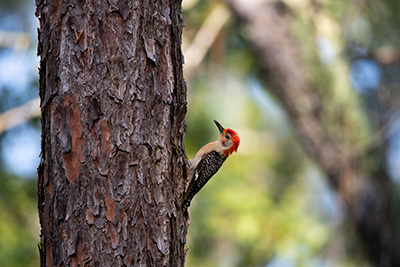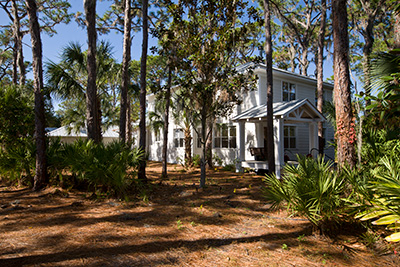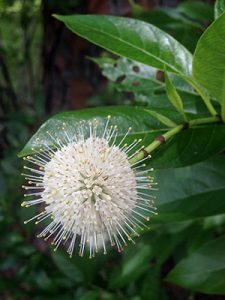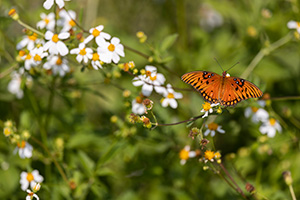How Can My Yard Contribute to Community Ecology?

It’s easy to think of our home landscapes as solitary bubbles that don’t interact with the land around them. However, our yards are becoming an increasingly important part of Florida’s ecology.
As Florida’s population rises, undisturbed areas are shrinking and becoming increasingly isolated. The state is now a network of urban and suburban areas, with rare patches of natural areas. With increasing development, wildlife movement will be further hindered without an ecologically thoughtful approach to our landscaping practices.
Having an ecologically focused yard doesn’t just benefit nature, a healthy ecosystem will reduce the amount of maintenance you’ll need to put in. This kind of landscape can naturally reduce pest and disease issues, which in turn requires less effort and chemical control. Your yard can become a beautifully interwoven community of plants and wildlife by simply adopting a few habits.
Limit Lawn Space
Unfortunately, turfgrass alone as a groundcover does not provide food or habitat for many wildlife species. You can improve the ecological contributions of your lawn and make it more biodiverse by introducing alternative, native groundcovers. There are plenty of attractive options that require less maintenance than traditional turfgrass and many benefit pollinators or other wildlife.
If you require turfgrass, then you can establish biodiverse, landscaped “islands” instead. Fill these islands with alternative groundcovers, wildflowers, or native plants. Place the islands near each other, if possible, so wildlife can easily move between them.
Provide Habitats

You may be tempted to remove dead trees from your yard, but leaving them as “snags” provides housing for insects and the birds that eat them. Just be sure to locate snags away from buildings.
Consider leaving some brush as well; leaving a few piles around your yard will provide cover and feeding opportunities to wildlife.
Leaf litter can also be used as mulch (and free fertilizer). Keeping leaves in your yard provides a place for many insects to overwinter and emerge from in the spring when birds and other wildlife are ready to feed.
Leaving dead stems on plants is also beneficial because this is where many pollinators hatch from. Edge the mulched areas and create paths to make it look neat.
Setting up bird houses, baths, and feeders will also support your local bird population. Vary the types of houses and feeders to encourage different species of birds to stop by. Consider installing a pond or water garden as a water source, too. Just make sure the water doesn’t remain stagnant and become a nursery for mosquito larvae.
The plants you choose also contribute to building a suitable habitat. For pollinators, you’ll need plants to support their larval stage as well as plants that provide nectar once they’re fully developed. Birds will then feed on the insects that appear, but you can also give them a varied diet by planting plants with berries.
Within your landscape design, aim to mimic natural areas with “vertical layering.” This means planting a variety of plants of different sizes and heights. Variation provides better cover and feeding opportunities for wildlife, while simultaneously adding interest to the landscape.
Remove Invasive Plants
Invasive plants are your worst enemy when trying to cultivate biodiversity. Invasive plants are defined as having been introduced to the area, are nonnative, and have caused (or will likely cause) environmental harm, economic harm, and/or harm to humans. Approximately 1.7 million acres of Florida’s natural areas are already consumed by invasive plants, and local ecosystems have been devastated as a result. Destroying any invasives that you find in your yard both prevents them from taking over and stops them from producing seeds that could spread elsewhere.
Just because a plant is being sold in a nursery does not mean that it is Florida-Friendly. A quick search of the plant name on the UF/IFAS Assessment of Non-Native Plants in Florida’s Natural Areas will confirm if it is invasive.
Plant Natives

Although it seems counterintuitive, you should plant natives because our insects can eat them. Finding a small amount of damage shows that your plant has ecological value. Non-native plants are often too different from our native species for them to qualify as insect food. A lack of insects leads to a lack of birds. Instead, plant natives to support a healthy insect population that will serve as a buffet for wildlife.
Don’t think that you need to replace every non-native in your yard today. Rather, plan to replace non-native plants as they die with comparable natives that will thrive in that location. Over time your landscape will become a flourishing community of native plants that are serving the ecological needs that wildlife depend on.
Limit Pesticide Use
If you’ve already implemented the steps above, you’re less likely to have severe pest infestations. Pest problems thrive in monoculture systems. Increasing species biodiversity, density, and spatial variance can lead to declines in arthropod pests and increases in their predators.
Often, beneficial insects are unintentionally killed when pesticides are applied. By broadly applying pesticides, both the pests and their predators are going away. Spraying yards for mosquitos is an example of a common practice with unintentional deadly consequences for beneficial insects. Instead, only spot-treat severe problems or use baits that target a specific species. You can also take a natural route by planting insect-repulsing plants (such as marigolds) in problem areas. Learn more about integrated pest management (IPM) practices.
Promoting Change

Hopefully, your neighbors will be so impressed by your wildlife haven that they’ll feel inspired to transform their yards as well. The more people prioritize local ecology in their landscapes, the more Florida’s ecology will strengthen. Wildlife will thrive, invasive plants will disappear, and native plants will once again support biodiversity.
For more information on how to support your community’s ecology, contact your county Extension office.
Also on Gardening Solutions
- Alternatives to Turfgrass
- Designing a Habitat Garden
- More on Florida-Friendly landscape care
- More on gardening with wildlife
- Recognition for Your Florida-Friendly Yard
- Weeds and invasive plants lists
More from UF/IFAS
- Getting Into the “Weeds:” An Introduction to Common Lawn Plants and Their Ecological Benefits in North Central Florida
- Landscaping Backyards for Wildlife: Top Ten Tips for Success
- Standardized Invasive Species Terminology for Effective Outreach Education
- UF/IFAS Assessment of Non-Native Plants in Florida’s Natural Areas
- More on landscaping for Florida wildlife from Ask IFAS
